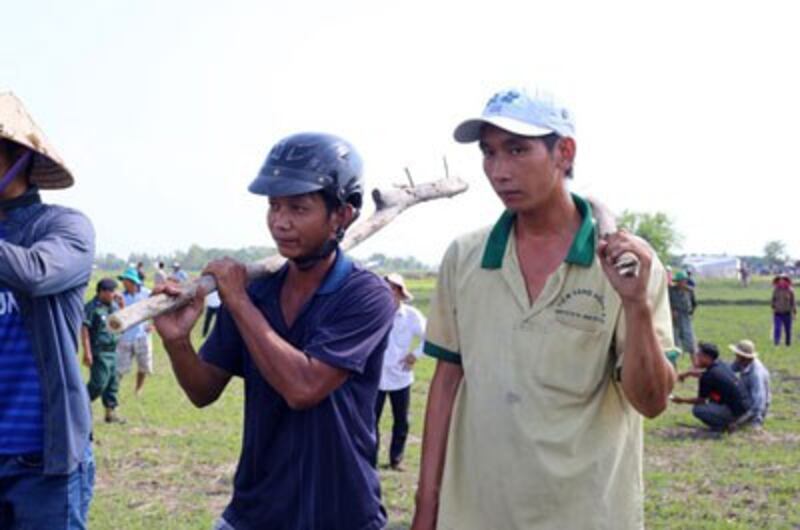Several activists from Cambodia were injured when a group of villagers from Vietnam attacked them with sticks while they inspected an area of the border shared between the two countries, the head of Cambodia’s opposition party said Monday.
The violence occurred Sunday when monks and opposition Cambodia National Rescue Party (CNRP) lawmakers led some 200 activists to examine the border in Svay Rieng province’s Kampong Ro district, where they say a road built by authorities in Vietnam’s Long An province has encroached into Cambodian territory.
Vietnamese villagers “charged the activists with sticks,” even though they were inspecting the area from within Cambodian territory, CNRP President Sam Rainsy told reporters outside the National Assembly, or parliament, in the capital Phnom Penh.
Several of the activists, including CNRP lawmaker Riel Khemarin and a monk who had helped lead the group, were injured in the attack and had to be helped away from the scene, he said, adding that he planned to file a complaint against the Vietnamese villagers through Cambodian authorities.
“We will file a complaint at the national and international level to prevent further violence against the Cambodian people,” he said.
“The Cambodian people are innocent [in this incident]. The Cambodian government and the people must unite to make sure that foreigners stop taking advantage of us.”
The Phnom Penh Post reported that 10 Cambodians and eight Vietnamese sustained injuries of varying severity during the clash.
The Post quoted both Riel Khemarin and another CNRP lawmaker, Sam An, as saying the incident was sparked by armed Vietnamese people.
The Svay Rieng provincial government defended local authorities in a statement issued Monday, saying they should not be held responsible for failing to protect the activists, who did not inform them that they planned to visit the border.
“The authorities advised them not to examine the border, but they didn’t listen,” the statement said.
“We were concerned about violence breaking out,” it said.
Ministry of Interior spokesman Khieu Sopheak told reporters that the area were the two groups clashed is yet to be officially demarcated.
He said he is proud that the people of Cambodia want to protect their country’s sovereignty, but warned that inciting violence would make the border demarcation harder to resolve.
“I urge all people to join with the government, which is working to resolve the border issue under the leadership of [Prime Minister] Hun Sen,” he said.
“We must unite as a nation to deal with the issue, which we take very seriously.”
Recent confrontations

Sunday’s violence is the latest in a series of confrontations between Cambodia and Vietnam over the border shared by the two nations.
Earlier this month, Cambodia issued a diplomatic protest to Vietnam requesting that the communist government stop building a military post on its territory in the Koh Thom district of Kandal province until the two countries have completed their demarcation of their borders in the area.
At the time, the CNRP said it would request that the government consider allowing opposition party members to serve on the border committee that oversees border demarcation, and called for the process to be halted until after Cambodia’s 2018 national election.
The letter of protest followed a similar one sent to Vietnam’s embassy on June 12 over a border issue in Ratanakiri province, accusing Vietnamese authorities of digging five ponds in an area that had yet to be demarcated.
The letter demanded that Vietnam respect the borderline and not make any changes to border markers or allow people to carry out cross-border cultivation or settlement, according to the terms of a joint communiqué the two countries signed in January 1995.
Cambodian activists claim that Vietnamese authorities and villagers have threatened to “kill them” on several occasions while they monitored suspected encroachment in disputed areas along the border.
Many Cambodians are wary of Vietnam’s influence over their country’s affairs.
An estimated 1.7 million people, or one in four Cambodians, died in what came to be called the “Killing Fields” after the ultra-Communist Khmer Rouge took power in 1975. The regime was unseated when Vietnam invaded the country four years later.
Reported by RFA’s Khmer Service. Translated by Samean Yun. Written in English by Joshua Lipes.
